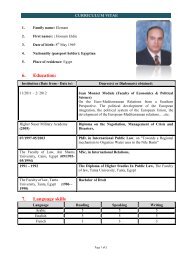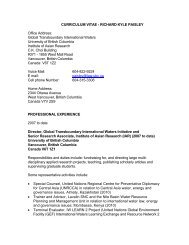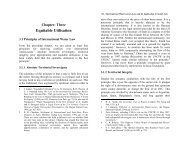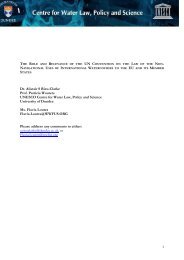Upreti, Trilochan, International Watercourses Law and Its Application ...
Upreti, Trilochan, International Watercourses Law and Its Application ...
Upreti, Trilochan, International Watercourses Law and Its Application ...
You also want an ePaper? Increase the reach of your titles
YUMPU automatically turns print PDFs into web optimized ePapers that Google loves.
58 / <strong>International</strong> <strong>Watercourses</strong> <strong>Law</strong> <strong>and</strong> <strong>Its</strong> <strong>Application</strong> in South Asia Development <strong>and</strong> Codification of <strong>International</strong> <strong>Watercourses</strong> <strong>Law</strong> / 59Without approval of IJC, no obstruction or the works onboundary waters was made possible. The dispute on the St.Mary <strong>and</strong> Milk River flowing across the boundary was settledon the basis of existing uses as agreed by the parties.Article II, which resembles the Harmon Doctrine, providesexclusive rights over the diversion of the rivers to the parties. 104It also provides that within their territory the watercourse statescan utilise waters as they please. However, arrangement hasbeen made that if such a diversion caused any harm or injury,the injured party would be entitled to the same legal remediesas if such injury took place in the country where such diversionor interference occurs. The Article states:"Utilisation <strong>and</strong> diversion of waters of rivers flowinginto boundary waters, as well as of waters ofsuccessive rivers. Respect for acquired rights withregard to navigation. Each party reserves for itself theexclusive jurisdiction <strong>and</strong> control over the use <strong>and</strong>diversion, whether temporary or permanent, of allwaters on its own side of the line which in theirnatural channels would flow across the boundary orinto boundary waters; but it is agreed that anyinterference with or diversion from their naturalchannel of such waters on either side of boundary,resulting in any injury on the other side of theboundary, shall give rise to the same rights <strong>and</strong> entitlethe injured parties to the same legal remedies as ifsuch injury took place in the country where suchdiversion or interference occurs; but this provisionshall not apply to cases already existing or to casesexpressly covered by special agreement between theparties." 105104 Supra note 23, p. 221.105 Supra note 36, p. 73.It must be acknowledged that during the negotiations on theColumbia River Treaty, Canada had attempted to invoke theprovision <strong>and</strong> bargained to divert the Columbia Rivers waterinto the Fraser River <strong>and</strong> to the ocean, which was flatly refusedby the United States. However, this argument was regarded asthe best tool to make the USA agree with the Canadianproposal on the said treaty. This example shows how stateschange their position when it appears that certain provisions ofa treaty could be used against their interests. Such is theimportance of bargaining power of a state in order to make theother state agree with it. It has been argued that the USA agreedto pay the downstream benefits to the Canadian wateraccumulation after the later plan to divert the water ofColumbia River into the Fraser River for Canadian absoluteuse. 106 However, it must be borne in mind that geographically,Canada is both in an upstream <strong>and</strong> downstream position.2.7.2 The Treaty of the Colorado & Lower Gr<strong>and</strong>e,1944 USA-MexicoThis treaty was also the result of a long <strong>and</strong> complicateddispute resolution effort between the United States <strong>and</strong> Mexico.The treaty provision 107 provides arrangements for the utilisationof the waters of the Colorado <strong>and</strong> Tijuana rivers, <strong>and</strong> of theRio-Gr<strong>and</strong>e (Rio Bravo). 108 The treaty was the most complete<strong>and</strong> satisfactory arrangement for the use of those waters byfixing <strong>and</strong> delimiting the rights of the two countries. However,the treaty provision adopted the notion of equitable utilisationregardless of the fact that the USA had taken an extremeposition in the negotiation but later changed her positionrecognising Mexico’s equitable share in these shared resources.It is the best example of cooperative <strong>and</strong> equitable sharing of106 R. W. Johnson, “The Columbia Basin”, in A.H. Garretson, et al (eds),The <strong>Law</strong> of <strong>International</strong> Drainage Basins, New York: Oceana Pub.,1967, pp. 201-211.107 Supra note 36, pp. 80-83.108 3 UNTS 995, p. 314.












